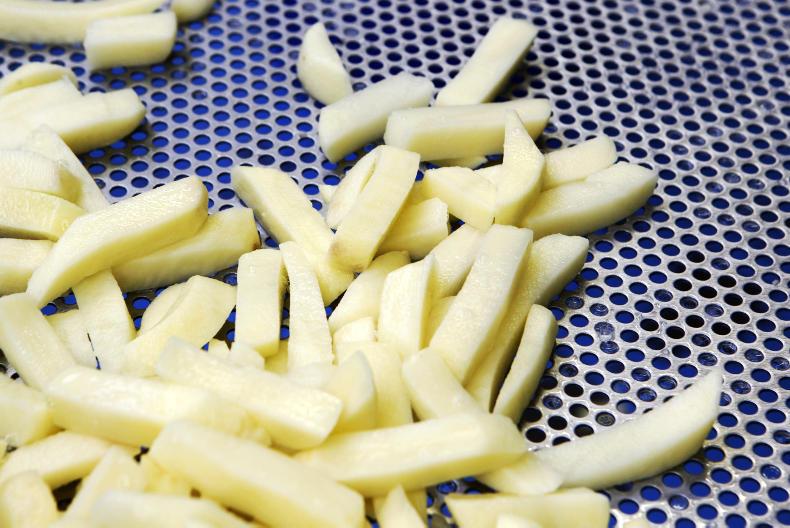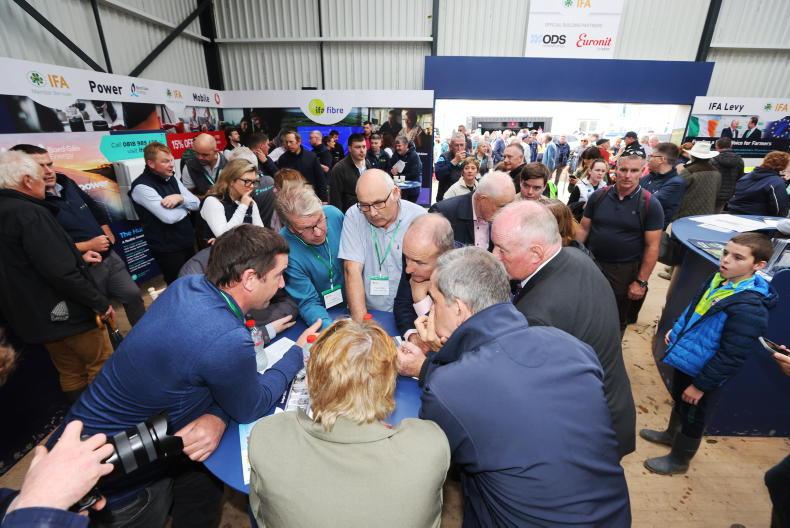While renowned for its high-quality potato production, when it comes to producing chipping varieties on a meaningful scale Ireland is missing an opportunity. There are a number of challenges which growers face when producing potato varieties suitable for chipping and frying. As a result, there are only a handful of farmers successfully growing the crop in Ireland.
According to the annual IFA potato area survey, in 2018 just over 500ac of potatoes grown for the fresh chip market were planted. As a result, the majority of Irish demand is met through imports. This leaves the country in a potentially vulnerable position, given the current uncertainty facing trading relationships with key partners like Britain.
Chipping potato imports
While further refining of CSO potato import figures is needed to accurately determine the volumes of imports which serve the fresh chip market, they help set the context for the programme. In 2018 Ireland imported approximately 74,000t of new and old-season, fresh and chilled potatoes. The destination for these potatoes included packing and peeling markets, but a significant quantity serves the fresh chip market. Over half of these imports originated from Britain. In the same year, Ireland produced an estimated 7,000t of potatoes destined for the fresh chip market.
While not the focus of the new programme, it’s still useful to examine the import figures for cooked and processed potato products. A significant volume of these imports include cooked, frozen chips available directly from retailers. Around 84,000t of processed potatoes were imported in 2018, 30% of which came from Britain.
The total value of these imports reached just over €121m in 2018. Given our reliance on imports, the uncertainty of Brexit and our ability to grow potatoes profitably, there is a significant opportunity for Irish growers to create a product capable of substituting some of those imports.
Irish fresh chip programme
Teagasc, the IFA and Bord Bia have recently launched a two-year pilot project which aims to address the key challenges faced by farmers when growing, managing and storing fresh chipping potatoes in Ireland. While the market may be poised for growth and there may be opportunities for new growers, they will only be working with a small number of existing growers for the duration of the programme.
Through forming a discussion group with a small number of growers, the stakeholders will run a series of workshops which focus on two key aspects of producing the crop: desiccation and storage. They will mainly focus on the varieties Markies and Arcade.
Desiccation: Desiccation at the correct stage is vital in chipping potato production, which is determined largely by tuber maturity. When desiccated at the correct stage the tuber will remain friable all season long. The agronomy package must be tailored as such so that the crop is beginning to senesce at the correct time to allow for a comfortable five-week skin set period post-desiccation. The loss of diquat will also pose a significant challenge in this. Understanding this timing and the effects of crop agronomy will be covered in the programme. Storage: The main challenge with storing chipping varieties is their requirement to be stored in ambient conditions at around 8°C. Furthermore, with the impending loss of CIPC, managing tuber sprouting while maintaining tuber sugar levels for frying means that storing chipping varieties for the duration of the season can be difficult. The programme will delve into storage tips and techniques for the crop.The programme takes over from the successful three-year salad potato programme. More updates on the Irish fresh chip programme are to follow throughout the year.
Read more
Potato stocks down a quarter
IFA potato report: early planting grinds to a halt
While renowned for its high-quality potato production, when it comes to producing chipping varieties on a meaningful scale Ireland is missing an opportunity. There are a number of challenges which growers face when producing potato varieties suitable for chipping and frying. As a result, there are only a handful of farmers successfully growing the crop in Ireland.
According to the annual IFA potato area survey, in 2018 just over 500ac of potatoes grown for the fresh chip market were planted. As a result, the majority of Irish demand is met through imports. This leaves the country in a potentially vulnerable position, given the current uncertainty facing trading relationships with key partners like Britain.
Chipping potato imports
While further refining of CSO potato import figures is needed to accurately determine the volumes of imports which serve the fresh chip market, they help set the context for the programme. In 2018 Ireland imported approximately 74,000t of new and old-season, fresh and chilled potatoes. The destination for these potatoes included packing and peeling markets, but a significant quantity serves the fresh chip market. Over half of these imports originated from Britain. In the same year, Ireland produced an estimated 7,000t of potatoes destined for the fresh chip market.
While not the focus of the new programme, it’s still useful to examine the import figures for cooked and processed potato products. A significant volume of these imports include cooked, frozen chips available directly from retailers. Around 84,000t of processed potatoes were imported in 2018, 30% of which came from Britain.
The total value of these imports reached just over €121m in 2018. Given our reliance on imports, the uncertainty of Brexit and our ability to grow potatoes profitably, there is a significant opportunity for Irish growers to create a product capable of substituting some of those imports.
Irish fresh chip programme
Teagasc, the IFA and Bord Bia have recently launched a two-year pilot project which aims to address the key challenges faced by farmers when growing, managing and storing fresh chipping potatoes in Ireland. While the market may be poised for growth and there may be opportunities for new growers, they will only be working with a small number of existing growers for the duration of the programme.
Through forming a discussion group with a small number of growers, the stakeholders will run a series of workshops which focus on two key aspects of producing the crop: desiccation and storage. They will mainly focus on the varieties Markies and Arcade.
Desiccation: Desiccation at the correct stage is vital in chipping potato production, which is determined largely by tuber maturity. When desiccated at the correct stage the tuber will remain friable all season long. The agronomy package must be tailored as such so that the crop is beginning to senesce at the correct time to allow for a comfortable five-week skin set period post-desiccation. The loss of diquat will also pose a significant challenge in this. Understanding this timing and the effects of crop agronomy will be covered in the programme. Storage: The main challenge with storing chipping varieties is their requirement to be stored in ambient conditions at around 8°C. Furthermore, with the impending loss of CIPC, managing tuber sprouting while maintaining tuber sugar levels for frying means that storing chipping varieties for the duration of the season can be difficult. The programme will delve into storage tips and techniques for the crop.The programme takes over from the successful three-year salad potato programme. More updates on the Irish fresh chip programme are to follow throughout the year.
Read more
Potato stocks down a quarter
IFA potato report: early planting grinds to a halt










SHARING OPTIONS